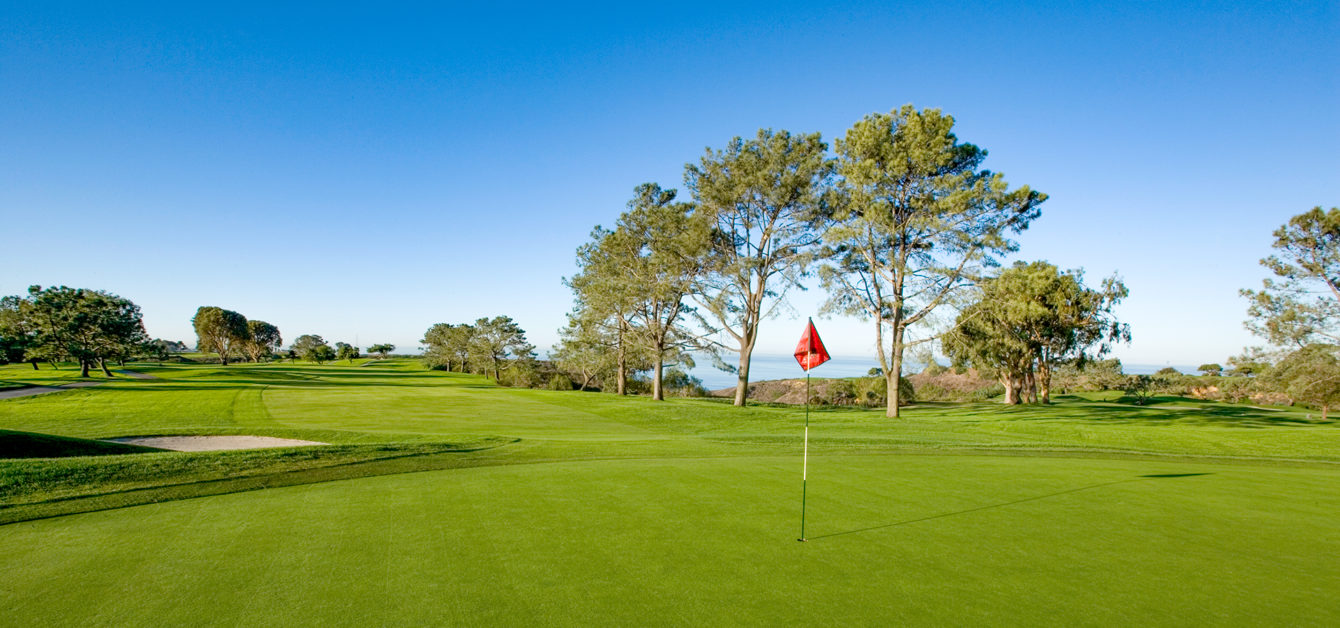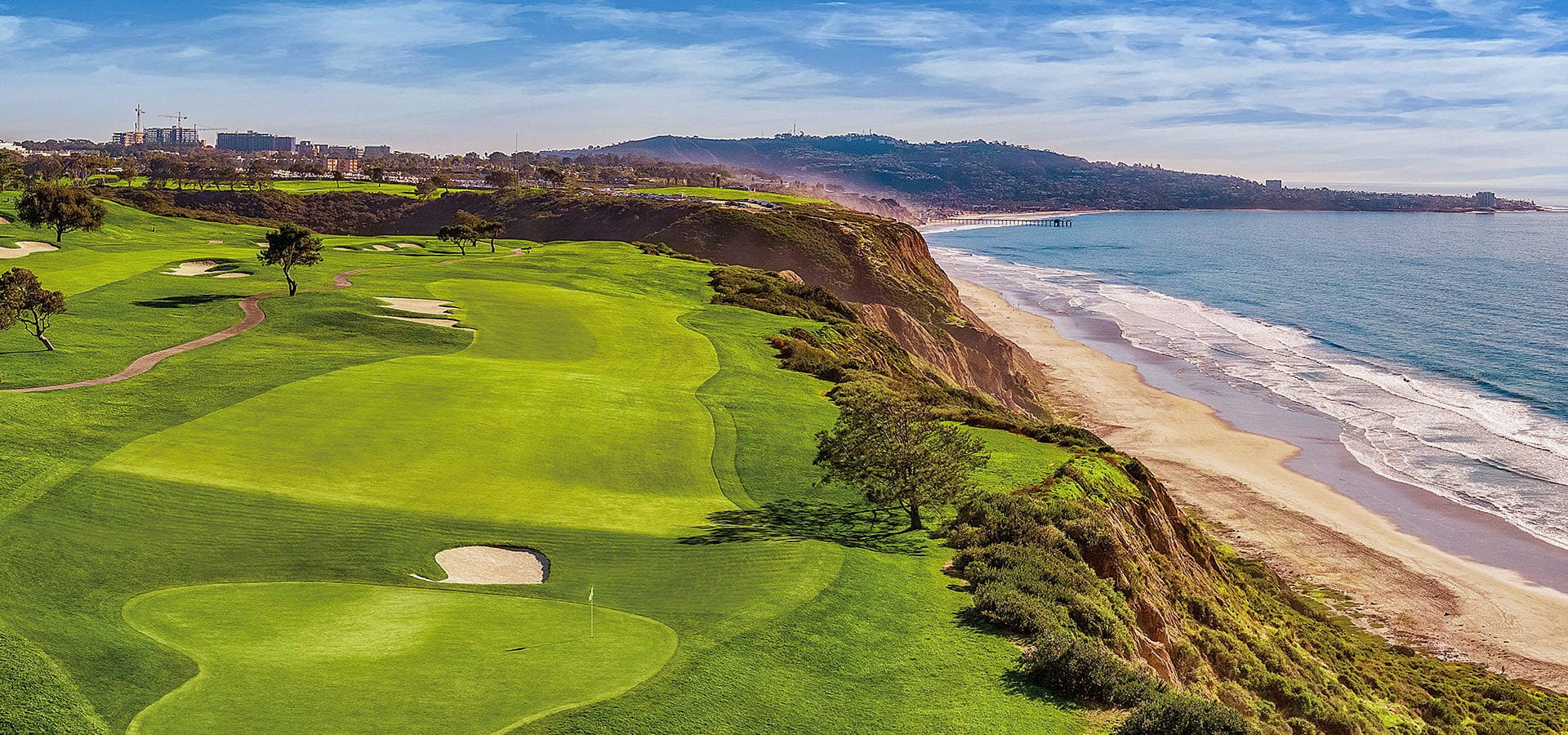Torrey Pines Golf Course Will Again Test the World’s Most Elite Golfers at the U.S. Open
Architect Rees Jones discusses the two decade transformation of the San Diego-region golf course.
-
CategoryExperiences, Outdoor Adventure, Unwind
-
Written byShaun Tolson
-
Above Image Courtesy ofTorrey Pines Golf Course
When the first tee shot is struck on the South Course at Torrey Pines on the morning of June 17—a golf shot that will signify the start of the 121st U.S. Open—a total of 4,746 days will have passed since the municipal course last hosted America’s most prestigious golf championship. Seven years prior to Torrey Pines hosting its first U.S. Open in 2008, the golf club’s more challenging course (the championship’s host venue) underwent significant renovations and redesigns courtesy of architect Rees Jones, who was entrusted with the task of transforming the public course into a layout worthy of hosting such an esteemed major championship.

Much of the heavy lifting that was required to transform the now-64-year-old course occurred in 2001; however, significant changes were implemented during the course’s second renovation, which Jones completed in 2019. After all, in the 18+ years since Jones had first modified Torrey Pines’ South Course, those 18 holes had logged more than 1 million rounds and had hosted an annual PGA Tour event every competitive season.
The U.S. Open returning to Torrey Pines marks the 14th time that the major championship will be contested in California, as well as the 10th time that it will be contested on a golf course that is open to the public. It also marks the fourth time that the U.S. Open has been played at a municipal golf club. The first occurrence was in 2002 at Bethpage State Park’s Black Course in Farmingdale, New York, which hosted the U.S. Open for a second time seven years later.
Because San Diego owns and manages Torrey Pines, city residents can play the U.S. Open course for as little as $63 during the week and $78 on the weekend. Nonresidents must pay significantly more ($202 during the week and $252 on the weekend). But those greens fees are still far more palatable than the going rate to tee it up at Pebble Beach—the only other U.S. Open venue in California that the public can play.
Regardless of the cost of a round, Torrey Pines’ greatest attribute as a U.S. Open venue is its aforementioned accessibility to the masses. The golf club is one of only seven open-to-the-public properties across the country where the U.S. Open has been contested, which means avid golfers of all ability levels can first watch the world’s best players compete this June for the prized trophy of the United States Golf Association (USGA) … and then later play a round of golf for themselves on those same fairways and greens.
To learn more about Torrey Pines’ transformation, as well as how the course will play during the upcoming major championship, we sat down with Jones for a candid discussion about course design and the merits of playing a round on the golf club’s South Course. On the latter topic, Jones shared a few tips that avid amateurs should take to heart—especially those who aspire to play on the prestigious, championship-caliber layout.

Transformative Measures
When avid golfers think of the South Course at Torrey Pines, they’ll likely first recall heroic shots hit by Tiger Woods during the 2008 U.S. Open, which the 15-time major champion won following an 18-hole playoff against Rocco Mediate. They may also remember some of the dramatic finishes that have occurred during the Farmers Insurance Open over the past 11 years. What they likely won’t recall, however, are details of the golf course as it existed before the current millennium.
Originally designed more than 60 years ago by William P. Bell and his son, William F. Bell, the South Course, which blankets a parcel of land that previously served as a naval training center, officially opened for play in 1957. Although the course enjoyed a long-standing history as an annual venue for a PGA Tour event, the layout lacked the requisite innate difficulty of a U.S. Open venue. Jones and his team were charged with the task of changing that.
Unlike some course design projects that attract numerous architects submitting bids for the work, Torrey Pines approached only Jones with the project’s proposal. By that time, the now-79-year-old architect had accrued more than 15 years of experience restoring and modernizing classic, golden-age American courses with the explicit goal of hosting major championships. By the early ’90s, in fact, Jones had garnered the nickname “The Open Doctor,” a moniker that his father, Robert Trent Jones Sr., had earned before him for similar restorative and renovative course design work.
Jones’ first project of this type occurred at The Country Club in Brookline, Massachusetts, during the mid-’80s. There, Jones and his team reshaped all of the greens (using archival photos as guideposts); excavated and restored original bunkers that had been filled in over decades; and lengthened the course as much as they could to keep it relevant to the game as it’s now played by golfers using technologically advanced equipment.
Thirteen years later, when Jones put on his surgeon’s gloves to prep the Black Course at Bethpage State Park for the 2002 U.S. Open, he followed a similar roadmap. “Bethpage Black was a restoration and a modernization at the same time,” he says. Jones sometimes likes to say that he restored the course in its original style but conditioned it for modern play.
At Torrey Pines, however, Jones’ work wasn’t restorative; it was transformative. In no uncertain terms, the work that Jones and his team executed can best be described as a comprehensive redesign. Greens were rebuilt, recontoured and relocated closer to several canyons that weave their way through the site. Fairway bunkers were repositioned to challenge today’s long-hitting players. And the course was lengthened by more than 500 yards from the championship tees.
“We changed the strategy of the course,” Jones says of his initial redesign work in 2001. “We built diagonal greens, and we redesigned a lot of the greens to have little tongues so they could hide the pin.
“They told us, ‘If you build it, they will come,’” he adds, reflecting on the marching orders that he received and the understanding that the USGA wanted to host the U.S. Open in Southern California but needed the right venue to do so. Those marching orders proved prophetic. In the year following the completion of Jones’ redesign of the South Course, the USGA announced that Torrey Pines would host the U.S. Open in 2008.
“We took a course on a beautiful site with a good routing and turned it into a championship routing as part of a championship rotation,” Jones says. “We made it into a championship golf course.”

All-Welcoming Designs
The work that Jones and his team completed more recently at Torrey Pines was as necessary as the efforts that were undertaken 20 years ago, even though this latest round of modifications to the course impacted it in more subtle ways. In particular, the latest renovations, which were completed in 2019, were done to benefit public golfers who play the course 51 weeks out of the year. “You don’t build a church for Easter Sunday,” Jones says, who often uses that statement to acknowledge that layouts like the South Course at Torrey Pines must remain playable and fun for the average golfer—even if those courses occasionally host major championships.
This time around, large-scale infrastructure improvements were made, including the installation of a new irrigation system. Additionally, sand bunkers were rebuilt, some were relocated, some were reshaped and others were eliminated to improve the quality of play for everyday players, not to mention to speed up the pace of play. On that last topic, more forward tees were added to one-third of the holes, while select sets of “intermediate” tees were relocated or expanded to improve playability.
A handful of holes also benefited from the creation of tightly mown chipping areas around the greens (which offer lesser-skilled players more recovery options), while all holes were enhanced by the implementation of new turf in the areas approaching the greens. “It was like Heinz 57,” Jones says of the mixture of grass varietals that previously made up those approach areas 15 yards or so short of the putting surfaces. Now all of those areas short of the greens are grassed with Latitude 36 bermudagrass, a species that is finer in texture and more resilient to colder temperatures.
All of those aforementioned turf improvements or additions around the greens reflect Jones’ upbringing in the Northeast, where he was exposed to the classic course designs of A.W. Tillinghast, an architect who would often create a green complex where a section of the putting surface was guarded by a bunker or a hazard but other areas were open and accessible.
“The ground game was in vogue when he was designing,” Jones explains. “Just watching the shot options that he utilized, that taught me. That’s what made me realize that you had to design for everyone’s abilities.”

Making the Rounds
During the third week in June, however, the abilities of only the world’s best players will be on display. While that’s also the case at the end of January or beginning of February each year when the PGA Tour rolls into San Diego for the Farmers Insurance Open, the course that U.S. Open competitors will encounter this summer will only look like that familiar layout. The course will assuredly play much harder.
Want proof? In 2008, prior to Torrey Pines hosting the U.S. Open in June, Tiger Woods won the PGA Tour event there in late January with a four-day total score of 269—that’s 19 under par. Woods’ U.S. Open victory a little more than four months later was accompanied by a much different score. After four regulation rounds, an additional 18-hole playoff and one requisite sudden-death playoff hole after that, Woods’ winning score was a single stroke under par.
“The terrain will be firmer and faster, especially the greens,” Jones says as a way of forecasting how the golf club’s superintendent (with the aid of John Bodenhamer, senior managing director for the USGA’s championships) will condition the South Course for the upcoming tournament. “They’ll be firmer and faster, and putts are going to break more.”
He adds, “The greens are what make any championship course these days because tour players are hitting the ball so far. At Torrey Pines, they can hide the pins behind the contours or in the corners of the greens.”
Due to winter overseeding, the rough that players will face during the U.S. Open will not only be significantly taller than it is during the Farmers Insurance Open, it will also be a different species of grass—one that will be thicker and more difficult to play out of. Because of that, Jones doesn’t anticipate the fairways being narrowed much, if at all, for the championship in June. The course—with its firm and fast greens, difficult hole locations and penal rough—will be aptly suited to repel low scores without further modifications.
What advice does Jones have for avid amateur golfers who want to play the course after the summer? For starters, he recommends tempering expectations—especially for players who might be experiencing the course for the first time. “You have to play a golf course several times to begin to understand it,” he says, “but the beauty of Torrey is that you can visibly see what your challenge is.”
The greens, which cover an average area of about 6,000 square feet, are boldly contoured and were shaped in such a way that many can feature challenging hole locations. For that reason, Jones advises many first-time players to take stock of a hole’s pin placement and to adhere to a conservative strategy with their approach shots. “The average golfer has to not always go for the pin if it’s hidden by a contour or a bunker or an angle,” he says. “They need to play to the center of the green.”
At times, those players would also do well to remember that the course was designed for players of all ability levels, which means they can play higher-percentage shots that bounce and roll up onto the greens. They won’t always need to attack a green from the air, even if those are the shots that the best golfers in the world will play the majority of the time during the U.S. Open.
“On a number of holes, they can access the green on the ground,” Jones reminds average players. “The pros don’t do that.”
Hermosa Beach Designer Draws Inspiration from His Southern Utah Roots
Nathan Anderson is a thrill seeker with no boundaries.
How to Make a Paloma
Celebrate your Cinco with a twist on this timeless tequila drink from our Mixed Messages team.
California Distillers Turn Spirits into Sanitizer Amidst Pandemic Shortages
Who says alcohol only has one use during quarantine?
Get the Latest Stories






